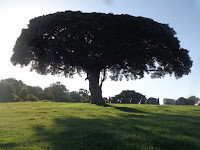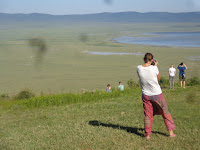So actually, Zanzibar was just a pit stop on the way to my main bucket-list trip: a safari in mainland Tanzania. I had always wanted to do a safari, but it wasn't until a friend (thank you, SS) recommended a specific tour operator that I got truly motivated to make it happen. Her guidance helped me cut through the overwhelming amount of travel-agency options. Tanzania Experience turned out to be the perfect choice for a customer like me, who required a lot of patience as she tried to plan her R&R during a government shutdown.
But everything came together in the end, and I was able to head off on my trip stress-free, knowing that all the details were sorted, including my domestic flight from Zanzibar to Arusha (top left). From the plane, I got just a quick glimpse of Mount Kilimanjaro (top right) before we landed at the airport in Arusha (bottom left). As we waited for our baggage to be unloaded, I surveyed the nearby mountains (bottom right). I don't know how I didn't realize that there would be so many, considering the country is home to the highest mountain in Africa.
The one mountain I didn't get to see very well was Mount Meru, which is ironic because I stayed at Meru View Lodge (top left). Clearly, I have been influenced too much by the setting of The Lion King because I also didn't realize how tropical the environs would be; the hotel grounds reminded me of Costa Rica (top right). The lodge is popular because it is within walking distance of Arusha National Park, but when I was there, almost in low season, there were few guests, and the beer garden was devoid of any party (bottom left). But that didn't matter because it was simply a place to get a good meal and good night's rest before setting off on the safari (bottom right).After breakfast the next day, my safari companions, two lovely Christinas from Germany; our guide, Enoch; our cook, Peter; and I loaded into our Land Rover (top left). Our first stop was Tarangire National Park, where a sign introduced us to the etiquette of wildlife watching (top right). Before going out to find some animals, we set up camp at the park's public campsite (bottom left). I opted for the tent safari not only because it was cheaper, but because I like camping, and I thought it would get me closer to animals. My choice was validated when some monkeys greeted us upon our arrival in Tarangire (bottom right).
It was almost low season because the rains down in Africa were about to begin. In some places, they had already struck, which resulted in some road blocks. Enoch skillfully maneuvered us around a truck that cracked its suspension when it bottomed out in a ditch created by sudden, swift rainwater (top left). After that driving demonstration, I had complete faith that we would survive some muddy off-roading (top right), and we did, with the help of all-wheel drive. The only obstacle that slowed Enoch down was a traffic jam created by trucks clustering near some lions (middle). Unlike the human variety, equine jackasses had enough competency and courtesy to cede the road (bottom left). As did the cattle we frequently encountered crossing the street as their Maasai herders led them to market or pasture (bottom right).
As we headed from Tarangire to our next camp, we set our sights on Ol Doinyo Lengai, or the Mountain of God, an active volcano that has erupted as recently as 2013 and is showing signs of blowing again. Upon our arrival, from a safe distance, we ate lunch overlooking the mountain (bottom left) and the nearby Maasai village that operates the camp and surrounding conservation area (bottom right).
The volcano, part of the East African Rift Valley, is unique because it spews carbonatite lava, the resulting magma of which actually promotes the growth of grasslands (top). This ecological divine intervention has created ground cover that is a perfect nesting ground for various water birds. While a local Maasai guide gave us a tour of nearby Lake Natron, pointing out the numerous species that literally flock there to lay eggs (bottom left), Enoch sought some higher ground in case the threatening clouds opened upon us (bottom right).
Later that night, we got drenched, but during the day, we didn't have any rainy respite from the 100-plus temperatures. Instead, we cooled our heels in a river a short walk from the campsite (top). We had to wade thigh-high in the river (bottom left) to get to Engare Sero Waterfall, where we stripped down to our swimsuits so we could splash through the cascade and slip down stony waterslides (bottom right). (Sorry, no waterproof camera means those memories reside in my mind alone.)
The next day, we had a long and arduous day of driving ahead of us. And luckily, the rain subsided, so we didn't have to portage across any unexpected floods. In fact, we were able to have a nice picnic beside one stream, which happened to also be a local watering hole for cattle (left). They were mellow enough lunch guests, but that didn't make me brave (or stupid?) enough to eat my boxed lunch next to pond full of hippos, like some we saw some tourists doing a few days later (right).
It was past dark and pouring by the time we reached our next stop, at Serengeti National Park. We were the only people at Lobo Campsite, so we pitched our tents in the covered dining hall and ate a candlelit dinner in the kitchen. It wasn't until sunrise the next morning that we saw what everybody else was missing (top left). The campground was nestled under a kopje reminiscent of Pride Rock (top right). (I have definitely watched The Lion King too many times.) And it overlooked a grassland valley where some buffalo enjoyed their breakfast (bottom).
The next night, we stayed in the Serengeti again, but we moved to the more central part of the park, to the Seronera Campsites. The location wasn't quite as spectacular and it was definitely more crowded, but it still put on a pretty good show at sunset, including a serenade by some stirred-up baboons (left). The next morning, just a few clicks from our tents, the sunrise synchronized perfectly with a lone acacia (right).
A baobab tree provided the centerpiece at our next campsite, at Ngorongoro Crater Conservation Area (top left). Some marabou stork gave us the side eye when we arrived (top right), but eventually they skedaddled, so we could set up our tents and carry supplies into the spacious kitchen (middle). Peter made us a feast that night, so we were well-fed and well-rested when we woke up at the crack of dawn (bottom left). Early though we were, everyone had the same idea, so we had to join a huge caravan heading down into the crater (bottom right).The day before, we stopped at the same viewpoint, and it was just as busy, albeit with fewer vehicles (top left). Some of the most unspoiled views came as we were climbing out of the crater, but there was no place to stop on the single-lane, one-way road. Somehow, I managed to snap a photo of a candelabra tree, a cactus-like succulent that the native Hadza tribe uses to poison its arrows (top right). Hadza warriors use their shooting skills to hunt food. Unfortunately, poachers still operating in the area kill rare animals for sport, status, and medicine -- or all three in the case of rhino horn (bottom left) -- as proven by a plaque at the conservation area's main lookout point (bottom right).










































No comments:
Post a Comment